
For many years now the ethical debate over bolting of British crags has raged, fed by the protagonists on both sides of the argument.
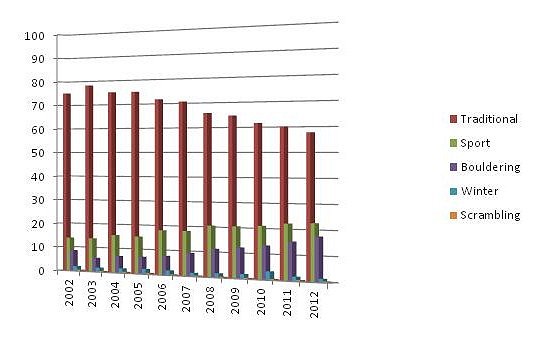
This "raises concerns that a small group of climbers armed with cordless drills can have an influence out of all proportion to their numbers in changing the character of a crag in just one weekend of bolting . It also notes that change made too fast leave the past behind since the local consensus has no chance to act in time to stem the tide of change". (Scott D, 2012 [online] The UIAA News [accessed 01 Dec 12])
"I have to say that your persistence, in the UK, in refusing any kind of sure and lasting protection baffles me! After all, you no longer climb with hemp ropes and iron crabs." (Paolo Vitali, 1997. Bolting the Alpine Environment. The Alpine Journal 1999, Pages 181 -183)
This ethical debate in the UK stretches right back to 1936 when two visiting Bavarian Climbers were scorned for placing pitons on the first ascent of Munich Climb on the flanks of Tryfan in North Wales. The climb was cleanly repeated by Colin Kirkus and Menlove Edwards, with Dick Barry later removing the three pitons using the infamous Helyg Poker from the climbers club hut.
Climbing styles and grades have evolved since these pioneering days, with climbing now being enjoyed through an expanding range of styles as each generation pushes the bounds of the possible. With the popularity of climbing growing one of the challenges for our sport is to ensure that it develops in a sustainable manner, critical to maintaining the aesthetics and diversity of the venues, but also ensuring we do not jeopardise hard one access agreements.
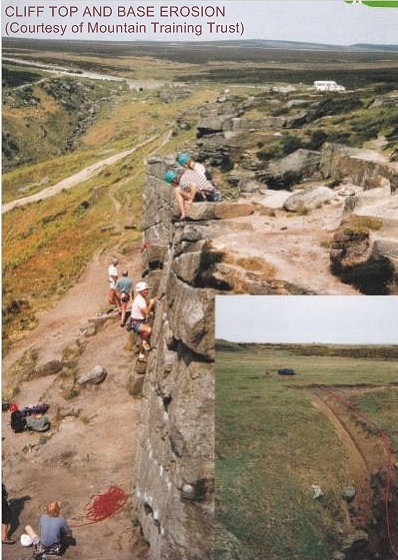
Studies in the USA and Canada conflict in their appraisal of climber induced environmental damage. By their very nature bolts are placed in areas where there is little in the way of cracks and ledges for protection, and therefore little flora to disturb. They prevent cliff top erosion and tree damage at popular belay stances and by following the line of bolts, can steer climbers away from more vulnerable areas. Whilst offering the mechanism to re-direct climbers to less vulnerable areas the accessibility offered by bolting increases the attraction of the area. Studies of the Red River Gorge in Ohio found footfall as much as three times greater on sport routes than comparable trad routes in close proximity. Whilst these examples are taken from the American experience similar impacts are visible in such UK sites, particularly in areas of low to mid grade climbs such as The Cuttings on Portland.
In contrast trad climbing which utilises cracks for gear placement may be responsible for the removal of flora from cliff face soil deposits. Assessment of the Joshua Tree National Park quantified the disturbance of vulnerable species which will struggle to re-establish, rapidly being replaced with hardier climber resistant species. Once reaching the cliff top sanctuary, tracks and tree scarring are common where belays are hastily constructed in the diminishing light of a successful day. The erosion at the top of crags is particularly noticeable where top ropes are rigged for group use, with large parties exaggerating the impact in small areas.
There can be no right or wrong in the debate over which style of climbing should dominate, to prevent the placement of bolts may be to limit the evolution of climbing, and yet once the drill has broken the silence of these hallowed crags, there is no going back, the possibility of progressive standards in trad climbing is stolen from the next generation by the presence of bolts.
Whilst the ethical debate on bolting has been played out many times and will continue to do so for many years to come, the immediate discussion over future developments may be better served by focusing on what is the right environmental decision. This objective approach may far better serve our purpose in the quest for better access arrangements, as all climbers seem to agree that the quality of the mountain environment is a key element in what draws them to these coveted cliffs.
.
"It is a result of "love the mountains" that climbers deplore the acts of defacement and defilement to which our mountains are often subjected. Defacement by chairlifts,railways, fixed ropes, paintmarks, pegmarks, rubbish, beaten paths – all are acts of assault upon a loved one and are therefore deplorable. Defilement by excessive indiscriminate promiscuity - so called "people pollution" – is also deplorable, particularly so when people do not love mountains. (Cambell R, 1974. Climbing Ethics, National Mountaineering Conference. (pages 281 - 289 ) in Wilson K, 1978. The Games Climbers Play, Diadem Books Ltd, London ISBN 0-906371-01-5).
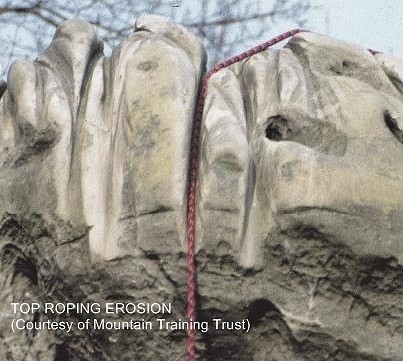
As climbers we have a number of opportunities to protect the venues which deliver us so many great experiences.
By promoting the individual assessment of each site the appraisal of environmental vulnerability may provide a tool for ensuring that whichever style of climbing is adopted, it provides the optimum solution for sustainability of the venue. Of course all of this would have to be conducted under the consensus of the local climbing forum.
In promoting the enjoyment of climbing anyone who instructs others, takes friends climbing or enjoys scarring the sedentary members of society with their tales of daring on facebook & twitter has an opportunity to encourage a culture of respect for the climbing environment. A culture which appears entrenched already amongst regular climbers but which may not be apparent to the newcomer where the adrenaline of the day pushes other considerations from their conscious thoughts.
Visiting some of the less well travelled routes; what they may lack in stars they make up for in the sense of adventure, along routes less well worn and reducing the intensity of use in other more popular sites.
The research into the environmental impact of differing climbing styles has many different facets, one of which is the behaviour and trends of the participants. If you would like to contribute then you can share your thoughts through the following survey being conducted through the Centre for Mountain Studies at the University of the Highlands & Islands.


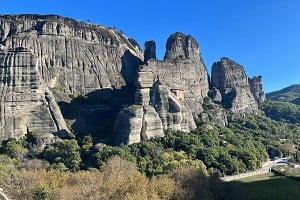
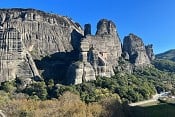










Comments